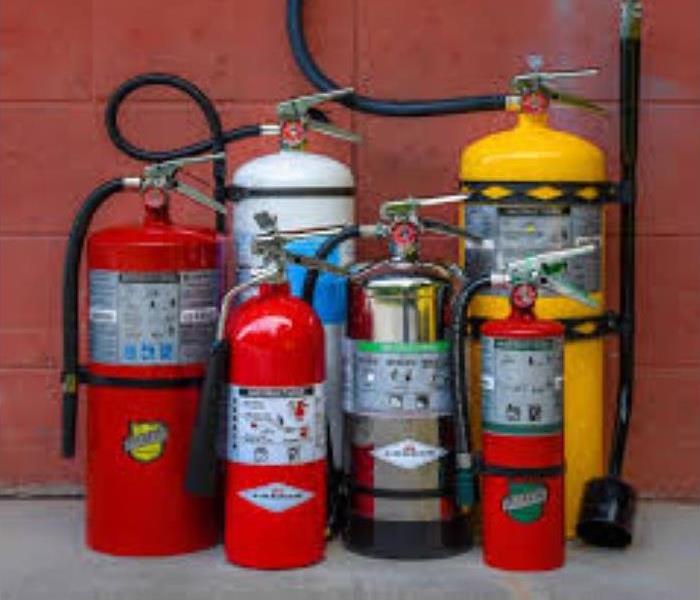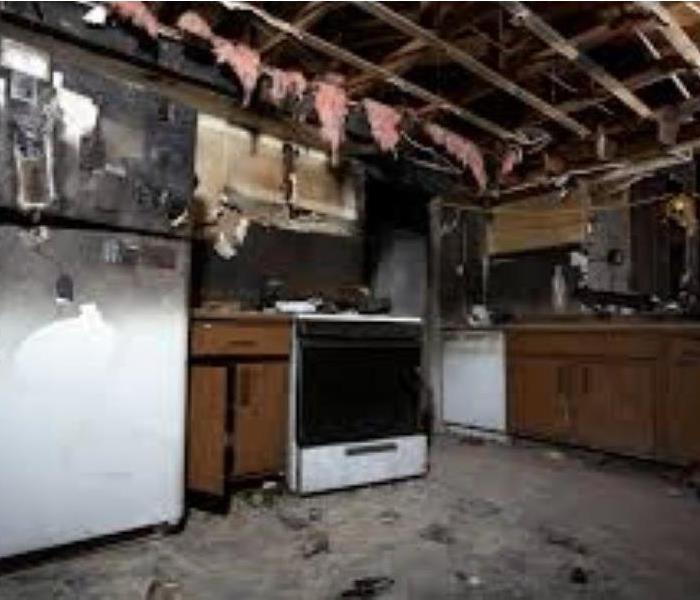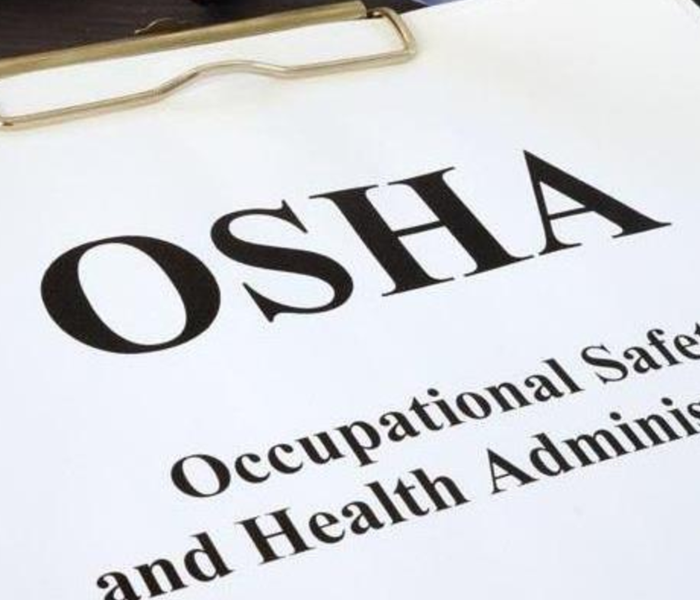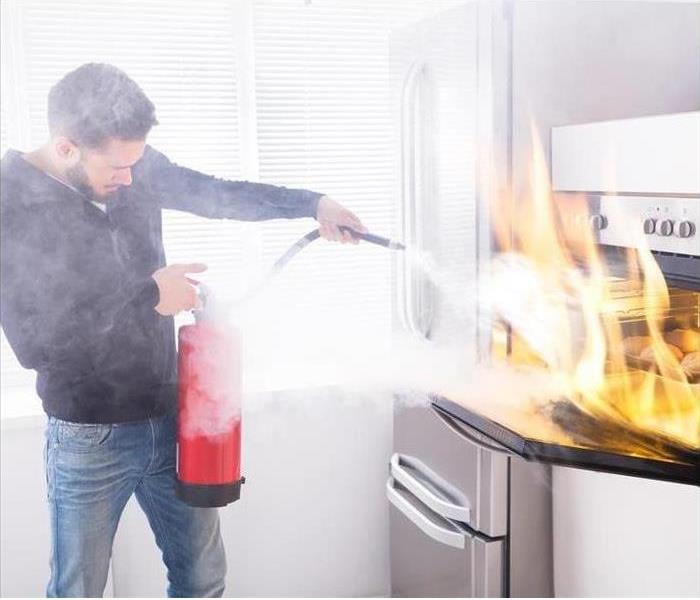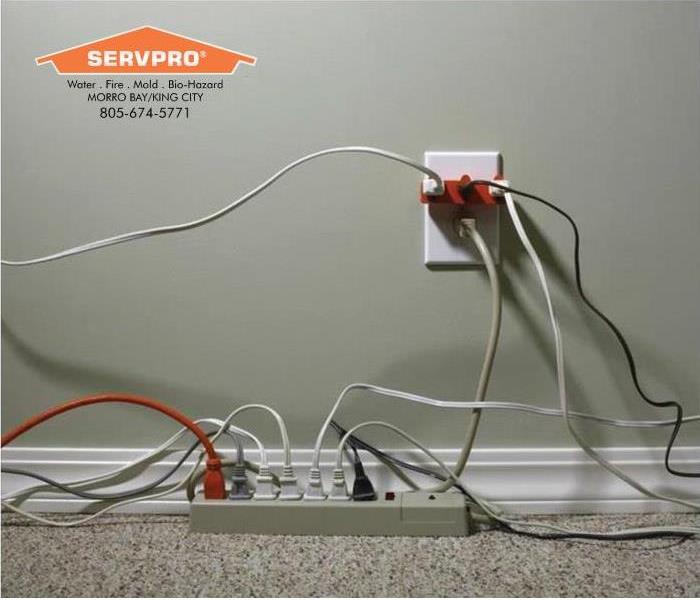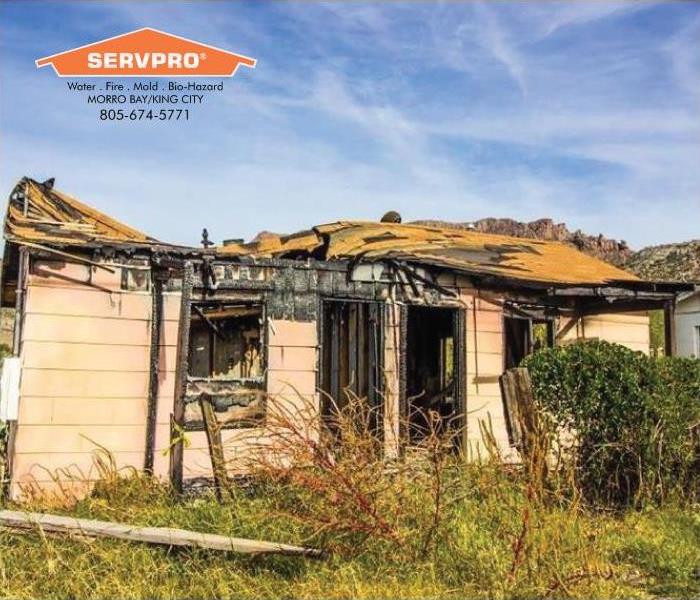Recent Fire Damage Posts
Preventing Kitchen Fires | SERVPRO of Morro Bay/King City
2/7/2024 (Permalink)
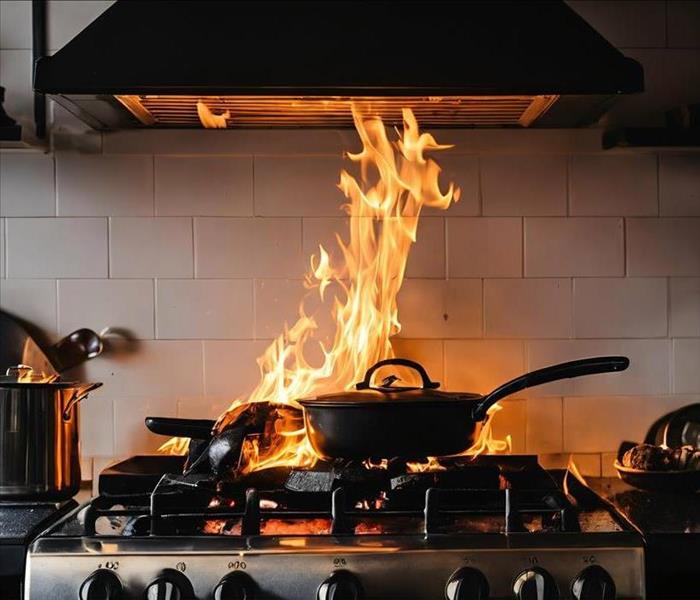 Has your home been impacted by a disastrous fire? SERVPRO of Morro Bay/King City wants to help restore it. Call us today!
Has your home been impacted by a disastrous fire? SERVPRO of Morro Bay/King City wants to help restore it. Call us today!
Where do you spend the most time when you are at home? You might assume it is your living area or a bedroom, but the more likely place is the kitchen. Think about everything you do in the kitchen and it makes sense—it really is the heart of the home.
The kitchen is also one the most common places that house fires start. There are so many potential hazards in the kitchen that it makes the place you spend most of your time one of the more dangerous spots you can be.
With some easy preventive steps, you can keep your house safe and continue enjoying the heart of your home. Keep reading to learn more from our SERVPRO® team.
Identify the Risks
The first step to protecting your kitchen and your home is understanding the risks. When you get to know the ways in which fires can start and spread, you can stay alert and stop problems before they ever begin.
Your stove and cooktop are the biggest risks in the kitchen. Any time you cook, there are a number of ways a fire could start.
Hot grease can pop out of a pan, water can boil over and cause an electrical spark or the kids’ favorite casserole can get too hot and flame up inside the stove. Even a loose sleeve or kitchen towel in the wrong place can lead to a fast-spreading fire disaster.
Other cooking appliances pose a risk as well. The microwave is another hazard, as foods inside it can overheat and burn or an electrical spark can cause flames. Any time you are cooking, in any appliance, stay close by.
Even an electric pressure cooker or slow cooker can lead to a fire. The closer you are, the faster you can react to prevent a total disaster.
Simple Prevention
While the risks in the kitchen may be great, so are tools for prevention. Staying close by is the best way to keep everything from going up in flames, quite literally.
When you cook, make sure you have a lid and a fire extinguisher within arms’ reach to put out sparks fast. Grease fires should be smothered, so even if the recipe doesn’t call for it, make sure you get a lid out when you are cooking on the stovetop.
Another simple way to keep things safe in the kitchen is to avoid clutter. It can be easy to toss a hand towel around while you cook, but make sure you keep it far from the oven or any other device that is turned on.
Don’t store items too close to the stove, either, including spoons or other utensils you may be using while you cook. Always turn on your oven light when you have something baking, and if it does catch fire, don’t open the door. Turn the oven off and wait for the flames to go out.
Paying close attention during cooking is crucial for preventing fires, but consider how you close down your kitchen for the day as well. We generally have a lot of electronic appliances in our kitchen that help make getting meals on the table easy.
Unplug as many of these as possible when they are not in use, and keep an eye on their electric cords. Clean grease or other residue off regularly, and don’t use cords that have visible fraying.
If your home is older, consider upgrading your outlets to GFCI outlets. These outlets have a fast-acting circuit breaker to prevent potential electrical surges. They are especially helpful in places like the kitchen where water may accidentally splash.
Make sure you have a smoke detector either in your kitchen or directly outside of it. Many kitchen fires spread because the smoke detector closest to where the fire started was disabled. Even if you frequently burn dinner, keep your smoke detector working and ready to protect your home.
Let the kitchen be the best room in your home by keeping things fire-safe. Stay close and keep safety equipment nearby so you can stop things before they get out of control.
Do you have smoke, soot or other fire damage in your home? Contact us to get things cleaned up fast.
Keeping Furry Friends Safe During Fire Damage Restoration
7/15/2021 (Permalink)
Keeping Furry Friends Safe During Fire Damage Restoration
Dog owners are understandably very relieved when their pets survive a home fire with no harm. However, they still worry about whether their pets will be safe during fire damage restoration in their Orlando homes. SERVPRO customers often ask us if it is safe for their pets to stay in the house while we work.
Can your pet stay in your home while SERVPRO is working?
We recommend moving your dog to a safe location outside of your home. Depending on the extent of the fire , there could be many hazards for them in your house:
- Nails, glass, or broken bits of wood on the floor
- Hanging drywall or collapsed ceilings
- Firefighting chemicals or leftover water from fire hoses
It is best for your pet – and better for your peace of mind – if you can arrange for them to go to a shelter or stay with a trusted friend or family member.
Kitchen Safety: Grease Fires
7/6/2021 (Permalink)
Kitchen Safety 101: Grease Fire Basics
Always give your full attention to cooking. It's sometimes difficult to do when family members are both working and schooling from home, but it is essential. Forty-nine percent of home fires begin with cooking equipment, and thirty-three percent of those are from unattended equipment! A moment's distraction could end in tragedy.
A grease fire is the most common type of kitchen fire. Smoking oil is a sign that the burner is too hot! Should a fire develop, turn off the heat immediately! When frying on the stovetop, always have a lid nearby to suffocate a fire. It is also important to keep a large box of baking soda on-hand to put out a small grease fire. Never pour water on a grease fire – it will only make it worse! Every kitchen should have a fire extinguisher as a last resort.
Once you've finished cooking, always clean up any grease splatter on and around the stove. Thoroughly clean the heating elements or glass top so remnants cannot catch fire the next time the stove is in use.
Air Duct Cleaning for your Morro Bay Home after Fire Damage
7/6/2021 (Permalink)
Air Duct cleaning for your Morro Bay home after a Fire
A fire in your Morro Bay/ King City home can result in a widespread amount of residual problems. For example, the ductwork for your air circulation system likely collected substantial amounts of dirt, debris, odors, and soot while the fire continued to rage inside your property.
Hire a professional it makes a difference!
In the event of a fire damage loss you want a professional on your side. SERVPRO of Morro Bay/ King City is highly qualified to handle all your fire restoration needs.
SERVPRO of Morro Bay understands your duct work
Understanding that the ductwork can often get a considerable amount of damage with a widespread fire, these areas are often part of the initial inspection conducted by our project manager and estimator. The combusted residue is typically acidic and can corrode these conduits if not dealt with quickly.
Board Up Service for your recent Fire Loss
7/5/2021 (Permalink)
SERVPRO of Morro Bay/King city is here for you after a Fire Loss
Experiencing a fire loss is one of the most emotionally traumatizing experiences for a home or business owner. After the flames have subsided their is just scorched rubble. The property is now very vulnerable. After the disaster of the initial loss you do not want to risk further damage.
Keep your property secure after a loss with our Board Up Services
SERVPRO of Morro Bay/ King city is here to provide all around customer care by offering board up assistance after a fire loss. The openings where your doors and windows used to be will be securely boarded up with plywood. It can bring some peace of mind to an already stressful situation. Our professionally trained team will do everything we can to ease the stress and secure your property to the highest industry standard. Call us today!
Fire Extinguisher Readiness
12/16/2020 (Permalink)
It’s December—time for Thanksgiving dinners and cozy fires in the hearth. It’s also a great time to review your fire extinguisher knowledge.
- Do you have a fire extinguisher? Do you know where it is?
- Do you know when your fire extinguisher expires? “You can tell the difference between the two by the head; a rechargeable extinguisher has a metalhead with a gauge that reads Charge/Recharge, and a disposable extinguisher has a plastic head with a gauge that reads Full/Empty.” (Keystonefire.com)
- Do you know how to use your fire extinguisher? The time to read the instructions is not when you reach for it in an emergency.
You should always familiarize yourself with the instructions for your specific extinguisher, but there are four basic steps to follow with a standard foam model. You can remember them with the acronym PASS:
- P—Pull the pin on the fire extinguisher.
- A—Aim the nozzle or hose at the base of the fire. Keep a safe distance away.
- S—Squeeze the handle to release the extinguishing materials.
- S—Sweep the nozzle from side to side.
Continue directing the foam at the base of the fire until it is completely extinguished.
If you have experienced fire damage, call SERVPRO of Morro Bay to King City to find out how we can help you make it “Like it never even happened.”
Avoiding Fire Damage In Your Home
12/8/2020 (Permalink)
Most electrical fires are caused by faulty cords, plugs and appliances so knowing safety and fire prevention are keys in avoiding fire damage to your home or business. The following are steps that homeowners and commercial property managers can take to avoid costly fire and soot damage.
Electrical Cord Safety:
- Inspect all cords for frayed or damaged casings
- Never damage or break off the third prong in a plug
- Never break off a third prong plug and plug into a two prong outlet
- Replace all 2 prong outlets with 3 prong outlets
- Do not pull out cords from the cord always pull out plugs from the plug.
- Use surge protectors sparingly as it is possible to overload a circuit if too many plugs are plugged into one outlet.
- Extension cords are to be used as temporary cords.
- Use the correct gage when using an extension cord
- Try to keep cords from running underneath a carpet or rug
- Keep cords away from water and heat sources
Appliance Safety:
- Follow manufacturers instructions
- Disconnect small appliances when not in use
- Disconnect appliances when you are going to clean them
- Unplug small appliances if you are going to leave town for an extended period
- Check phone chargers for overheating
At SERVPRO of Morro Bay to King City we are there to help our customers in a fire and soot damage situation with fast service in order to get you back on your feet. Please feel free to contact us at: (805) 674-5771
OSHA Guidelines For Fire Extinguishers
4/8/2020 (Permalink)
SERVPRO of Morro Bay / King City knows that the proper use of fire extinguishers can prevent fire from destroying lives.
Owning a fire extinguisher is not enough. The Occupational Safety & Health Administration (OSHA) requires that employers train their employees how and when to use fire extinguishers. They must provide the training shortly after the employee is hired, and then every year thereafter.
OSHA does not allow untrained employees to use a fire extinguisher.
OSHA also requires monthly inspections of the fire extinguishers.
Fire extinguishers have to be placed where they cannot be moved or damaged..
The carrying handle should be 3-1/2 to 5 feet above the floor.
Employees must know when to use fire extinguishers.
SERVPRO of Morro Bay / King City suggests asking yourself these questions regarding fire extinguishers.
- Have I pulled the fire alarm?
- Is the fire extinguisher easy to reach?
- Do I know how to use it?
- Is the fire contained in a small area?
- Is the smoke non-toxic?
- Can everyone get out?
- Do I have an escape route?
If you can answer “yes” to all of the questions, it is reasonable to use the fire extinguisher.
SERVPRO of Morro Bay / King City reminds you that fire is fast. If you cannot contain it within 30 seconds, get everyone out of the area. Call 9-1-1 once you are outside.
Links:
https://www.osha.gov/SLTC/emergencypreparedness/index.html
https://www.osha.gov/laws-regs/regulations/standardnumber/1910/1910.157
https://www.nfpa.org/public-education/by-topic/fire-and-life-safety-equipment/fire-extinguishers
Fire Hazards in the Kitchen San Luis Obispo County
4/8/2020 (Permalink)
Fire accidents are something that people think will never happen to them. As we’ve seen in recent months in California, forest fires can be extremely dangerous and destruction to anything and everything near and in its path. It is important as California residents to understand that there are still a lot of risks when it comes to fires and your home or commercial property. The National Fire Protection Association (NFPA) recently released a report stating that 2 in every 5 home fires in the United States begin in the kitchen.
Cooking is a fun activity that is enjoyed by friends and family of all walks of life. Some of a family’s best moments are those spent in the kitchen cooking, eating, and enjoying each other’s company. Unfortunately, the kitchen is also a potentially hazardous place when it comes to fires. The following are some of the biggest fire hazards in the kitchen:
- Ovens
- Stovetops
- Grills
- Broilers
- Microwaves
- Grease build-up on stovetop
- Electrical wiring
- Loose clothing near open flames or on the stovetop
Being aware of the above hazardous items is important to maintain a safe and secure kitchen area. It is important to keep a fire extinguisher near or inside of the kitchen in the event that a fire starts. Cooking fires are the leading source of fires throughout the country, so being hyper-aware of the potential risks associated with kitchen items is important. If you have experienced a kitchen fire, contact our team at SERVPRO to take care of the cleanup and restoration.
Electrical Safety for Your Children
4/8/2020 (Permalink)
Homeowners often think of fire and electrical safety in regards to protecting their family and their property, but considering these practices from a child’s perspective is imperative to truly keeping your loved ones and home safe from harm. When discussing these issues with kids, it is best to break things into two categories in order for them to be easily understood and readily followed. Far too many parents sit their children down and offer guidelines given to them, which are difficult for kids to understand and put into practice. As such, today we offer some easy tips for explaining electrical safety to your children.
Below, we will break down how to help your children with identifying safe practices versus unsafe practices. Be sure to talk through these items with your kids slowly and carefully.
The following practices and ideas are positioned in the “safe” category:
- Help your parents by reminding them to test your smoke alarm monthly and change the smoke alarm batteries yearly
- Be sure to turn off the lights when leaving a room and before going to sleep
- If you see smoke or a fire, leave your home right away and call 911 from a safe location
- Make sure space heaters have a space, do not place anything that can burn anywhere near them
The following practice and ideas are positioned in the “unsafe” category:
- Never use or touch electrical cords that are broken or frayed
- Always keep electronics far away from any liquids
- Do not overcrowd electrical outlets with cords, if there are too many in one location ask an adult to remove some
- Do not put anything that can burn near lightbulbs or lampshades
Electrical safety and fire safety are important subject matters that must be addressed by parents on a regular basis. Make it a habit to ask your children questions to ensure that they are well-versed on the above safety tips at all times.
Fire Disasters Not Covered by Standard Home Insurance in San Luis Obispo County
4/8/2020 (Permalink)
Many people assume that a home fire is covered by their insurance policy. In reality, most insurance plans only cover specific types of fire disasters. Learn which circumstances can qualify you for reimbursement and which ones can leave you with a large bill.
Arson: A Dead End
When a homeowner deliberately sets fire to property, then authorities consider it a criminal offense. A common motivator for this crime is to collect insurance money, and companies are aware of this fact. They often send investigators to assess the fire damage to a property. If arson is suspected then there is no financial reimbursement.
Fire in a Vacant Home: No Luck
Insurance companies typically define a vacant home fire according to these points:
- No occupation for at least 30 days
- A property that is purchased, but the homeowners haven’t moved in yet
- Homes that are rented out but currently free of tenants
Vacant homes are a large risk to insurance companies because a fire cleanup tends to be more severe. If you want to secure your property against a possible home fire, then you can purchase an endorsement to an existing policy. This is a good idea for a summer home, for example, that is not occupied for part of the year.
Commonly Covered Circumstances
Disasters and fires that occur from an appliance malfunction, vandalism, wildfire or lightning strike can often qualify for coverage. In these cases, you and your family may not have to pay for a fire damage cleanup company in San Luis Obispo County, California out of pocket. If someone was hurt during the incident, then insurance can also cover medical costs. Insurance companies have to make a profit, but they are also concerned about the well-being of their clients.
Understanding the details of your homeowner's insurance can be useful in the event of a home fire. Fires resulting from arson and vacant home fires often do not receive financial assistance.
 Has your home been impacted by a disastrous fire? SERVPRO of Morro Bay/King City wants to help restore it. Call us today!
Has your home been impacted by a disastrous fire? SERVPRO of Morro Bay/King City wants to help restore it. Call us today!





 24/7 Emergency Service
24/7 Emergency Service
